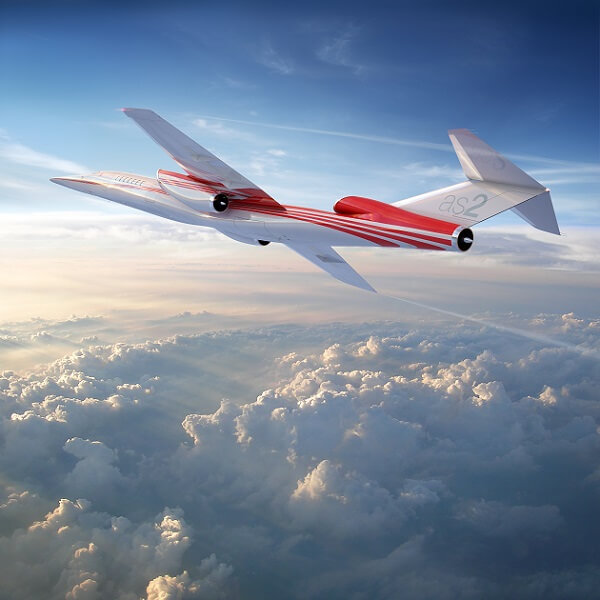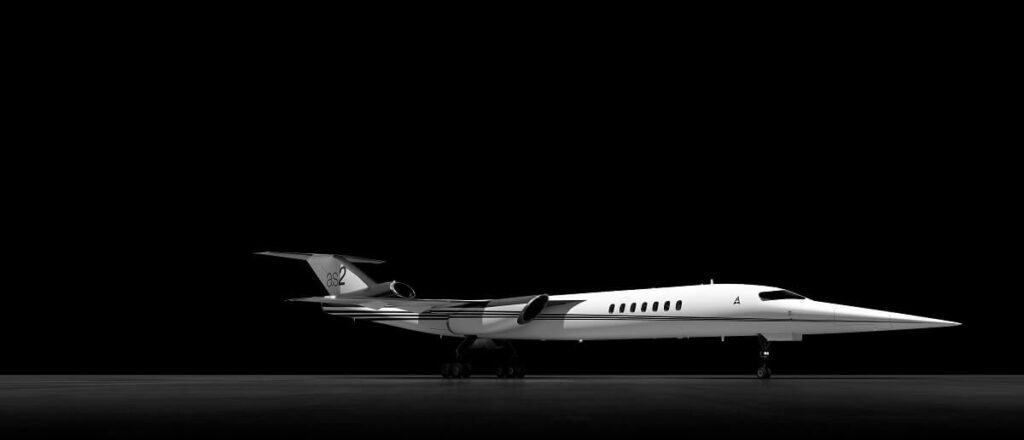It is becoming increasingly harder to keep up with all the latest developments in the industry-wide efforts to revive faster than the speed of sound air travel. Everyone wants to get hold of the lucrative market of future supersonic passenger flight: from plane makers, aerospace and defense companies to even national space agencies. Having recently made a “significant investment” in Aerion, Boeing is keen on bringing the AS2 supersonic business jet to market, while also working on its own hypersonic aircraft. Meanwhile, Aerion’s partner Lockheed Martin has decided not to renew their agreement, pulling out as it focuses on building NASA’s X-59 jet.
Boeing Jumps In
On February 5, 2019, Boeing announced it has made a significant investment in the supersonic business jet developer Aerion with the aim to accelerate the technology development and aircraft design of Aerion’s AS2 jet. For that purpose, the U.S. industry giant says it will provide the startup with financial, engineering and industrial resources.
Supersonic flight can safely and efficiently connect the world faster than ever before! We are partnering with @AerionCorp to lead the future of time-saving travel. #TheFutureIsBuiltHere
Read more: https://t.co/RF91BSS8z6 pic.twitter.com/LV9nAG2xVO— The Boeing Company (@Boeing) February 5, 2019
“Boeing will provide engineering, manufacturing and flight test resources, as well as strategic vertical content, to bring Aerion’s AS2 supersonic business jet to market,” the two companies state in the official press release announcing their new partnership.
The partnership, terms of which have not been revealed, will see the involvement of Boeing NeXt, the division focused on next-generation mobility systems, including passenger-carrying hypersonic aircraft, in the AS2 project.
“This is a strategic and disciplined leading-edge investment in further maturing supersonic technology,” said Steve Nordlund, vice president and general manager of Boeing NeXt. “Through this partnership that combines Aerion’s supersonic expertise with Boeing’s global industrial scale and commercial aviation experience, we have the right team to build the future of sustainable supersonic flight.”
The 12-seat AS2 supersonic business aircraft is designed to fly at speeds of up to Mach 1.4 (approximately 1,000 mph or 1,609 km/h). For comparison, one the fastest subsonic business jets out there today, the 17-seat Gulfstream G650 can reach top speeds of Mach 0.925 (approximately 610 mph or 982 km/h).

Illustration of Aerion’s AS2 (Aerion Supersonic)
According to Aerion, the AS2 would be capable of flying up to 70% faster than current business jets and should save approximately three hours on a transatlantic flight, while meeting environmental performance requirements. “The AS2 is the launch point for the future of regulatory-compliant and efficient supersonic flight,” says Tom Vice, chairman, president and CEO of Aerion.
Founded in 2003, the Nevada-based company had been working on developing new, more efficient aerodynamic technologies for supersonic aircraft. It first introduced the AS2 design in 2014, and concluded the conceptual design phase of the program in 2018. This phase involved the unveiling of the initial design of the first supersonic engine purpose-built for business jets, the GE Affinity turbofan, which will power Aerion’s AS2.
Boeing and the startup seem confident that the AS2 “will be the first supersonic business jet to market” and will eventually “unlock supersonic air travel for new markets”. Aerion is now aiming to complete the preliminary design stage of the program in June 2020 and see the AS2 take off for its first flight in 2023, with certification expected in the following two years.
But the manufacturer has one major rival: the Boston-based Spike Aerospace, which is aiming to build an even faster (top speeds of Mach 1.6, approximately 1,200 mph or 1,931 km/h), “quiet” supersonic airplane. The 18-seat S-512 is expected to enter into service around the same time as the AS2. And according to Reuters, Spike already has two orders for the aircraft.
Lockheed Pulls Out
Among Aerion’s several big name partners was Boeing’s rival Airbus. In the early stage of the AS2 program, the startup had established an engineering collaboration with the European plane maker, which saw the two companies develop a preliminary design of wing and airframe structures, systems layout, and preliminary concepts for a fly-by-wire flight control system of the AS2.
Aside of the engine maker GE Aviation, Aerion is currently collaborating with Honeywell to provide avionics for the AS2. Until recently, it had also worked with aerospace giant Lockheed Martin. According to a February 11, 2019 report by FlightGlobal, Lockheed has pulled out of its involvement with Aerion having decided not to renew its contract with the next-gen supersonic jet developer.
Some time back, on December 15, 2017, Lockheed announced it had signed an agreement with Aerion, under which, the two companies would work together in developing the AS2. “Aerion and Lockheed Martin announced a Memorandum of Understanding (MOU) today to define a formal and gated process to explore the feasibility of a joint development of the world’s first supersonic business jet, the Aerion AS2,” an official press release by Lockheed Martin reads.
The MOU was the result of extensive discussions between Aerion and Skunk Works, Lockheed Martin’s division for Advanced Development Programs (ADP). As part of the agreement, over the following year, the two companies were to develop a framework on all phases of the AS2 program, including engineering, certification and production.
Illustration of Aerion’s AS2 supersonic business jet (Aerion Supersonic)
At the time, the initiation of the partnership was celebrated by both companies. Here is what Aerion’s Chairman Robert M. Bass had to say: “This relationship is absolutely key to creating a supersonic renaissance… We share with Lockheed Martin a commitment to the long-term development of efficient civil supersonic aircraft”.
Lockheed, on its part, reiterated its commitment to supporting new innovations and developing supersonic technologies with various civil and commercial applications. “We are committed to remaining on the cutting edge of aerospace technology and are excited to examine the contribution we might make to working with Aerion on making aviation history,” said the Executive Vice President of Lockheed Martin Aeronautics, Orlando Carvalho, in the release.
According to the recent report, Lockheed told FlightGlobal that it had “no plans” to renew the agreement after its contract with Aerion expired on February 1, 2019. The company also said it did not invest (at least financially) in the startup and that its partnership with Aerion was simply to assess the technical viability of the AS2 jet design.
That is despite the fact that, at least initially, Lockheed seemed to have been quite “invested” in the AS2 project. “Following our initial review of Aerion’s aerodynamic technology, our conclusion is that the Aerion AS2 concept warrants the further investment of our time and resources,” Carvalho stated back in 2017 when announcing the partnership.
How About the Hypersonic and X-plane programs?
Boeing and Lockheed already have their plates full when it comes to next-generation supersonic aircraft development. Boeing’s decision to step in and assist Aerion in its efforts to revive civil supersonic flight raises some questions. It is hard to determine which of the two manufacturers – Aerion or Spike (and let’s not forget Boom, which is developing a supersonic passenger airliner) – has made more significant advancements in developing the technology for supersonic aircraft.
Little detail, aside of the concept design and engine selection, has yet been released by any of those startup companies. But Boeing’s backing of Aerion seems to indicate that at least in the industry giant’s eyes it presents more potential than all other startups out there. And Boeing is surely not wasting time to tap into the promising market of future supersonic passenger flight.
But how about Boeing’s own hypersonic aircraft aspirations? Just last year, on June 26, the U.S. plane maker revealed an early concept for its first hypersonic passenger plane, one of the several concepts with a wide range of potential applications that the company said it is currently studying.
First concept of Boeing’s hypersonic plane (Boeing)
“We’re excited about the potential of hypersonic technology,” said Kevin Bowcutt, senior technical fellow and chief scientist of hypersonics. “Boeing is building upon a foundation of six decades of work designing, developing and flying experimental hypersonic vehicles, which makes us the right company to lead the effort in bringing this technology to market in the future”.
According to Boeing, its engineers are working companywide to develop the necessary technology that would ensure the company is prepared for “the time when customers and markets are ready to reap the benefits of hypersonic flight”. However, as Bowcutt added, a hypersonic passenger vehicle could possibly be airborne in only 20 to 30 years.
Hence, might it be that the collaboration with Aerion is an opportunity for Boeing to help advance and study upon supersonic aircraft technology that would later “accelerate”, as it has said, the development of its own hypersonic aircraft? Or is the partnership indeed an effort by the plane maker to seize market opportunity early on?
As for Lockheed, in April last year, the aerospace company was awarded a $247.5 million contract by NASA to design, build and flight test a low-boom flight demonstration aircraft that could minimize the sound of a sonic boom – a major sticking point for all developers of high-speed passenger planes due to the current noise restrictions banning commercial supersonic flight over land.
In February 2016, Lockheed’s Skunk Works were already awarded a contract to develop the preliminary design of the supersonic flight demonstrator, known as the X-plane, for NASA’s Low-Boom Flight Demonstrator program.
The 2018 deal with the space agency will see Skunk Works actually build a full-scale experimental supersonic aircraft of that preliminary design developed under NASA’s Quiet Supersonic Technology (QueSST) efforts. The building of NASA’s X-59 plane will be carried out at Skunk Works facility in Palmdale, California.
Illustration of NASA’s Low Boom Flight Demonstration aircraft (NASA/Lockheed Martin)
“We’re honored to continue our partnership with NASA to enable a new generation of supersonic travel,” said Peter Iosifidis, Low-Boom Flight Demonstrator program manager at Lockheed Martin Skunk Works in an official press release announcing the recent agreement.
“We look forward to applying the extensive work completed under QueSST to the design, build and flight test of the X-plane, providing NASA with a demonstrator to make supersonic commercial travel possible for passengers around the globe,” Iosifidis added. The X-59 is already slated to conduct its first flight in 2021.
Whether or not Lockheed sees more potential in NASA’s project than in Aerion’s business jet, the company has now surely thrown all of its efforts into the X-plane program. After all, Lockheed almost exclusively works for U.S. government bodies, such as the Air Force or NASA, rather than with private companies. It is in the public sector that Lockheed has surely made its biggest mark so far, as the company’s dominance of the U.S. military market, for example, shows.

